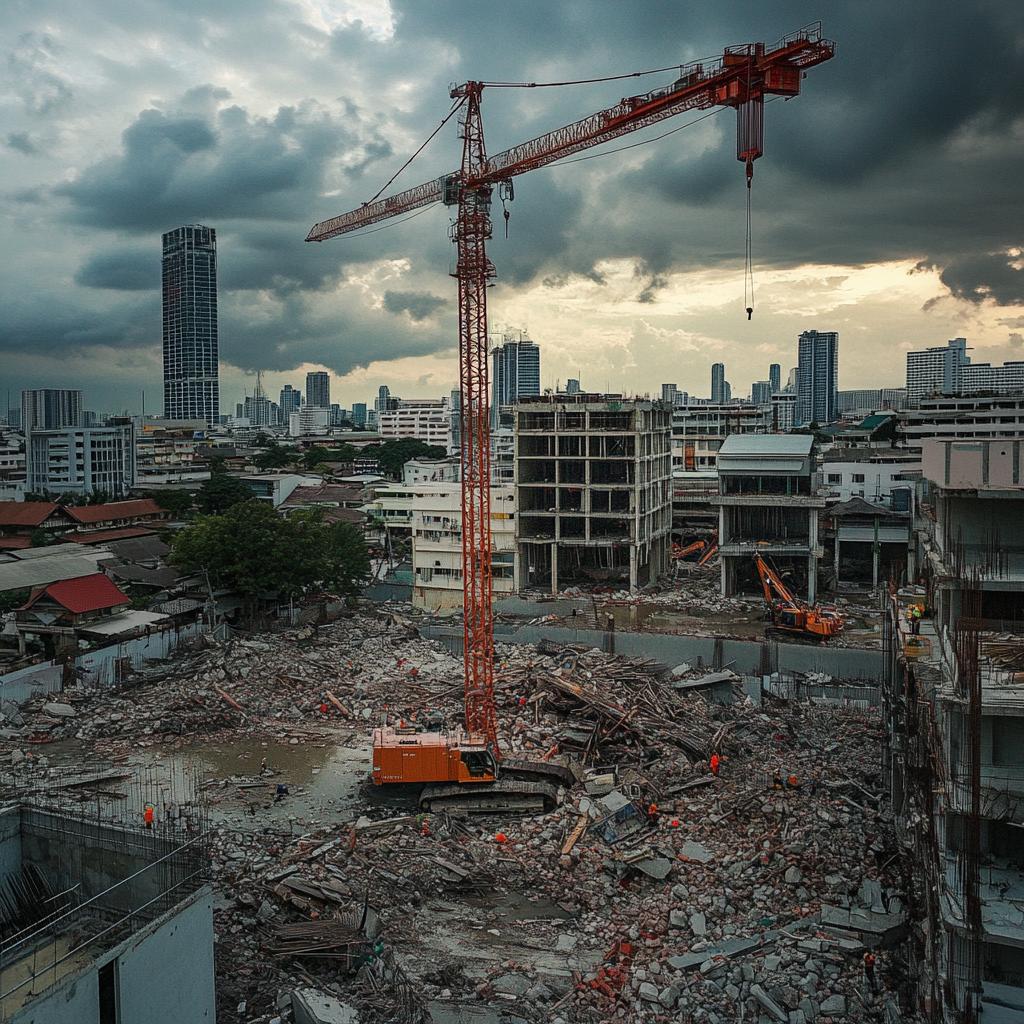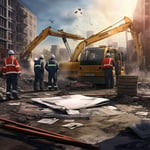In the bustling metropolis of Bangkok, where the city skyline is dotted with cranes stretching towards the heavens, an unexpected tragedy unfolded that has left the community reeling. Yesterday, on March 28, what seemed to be a routine day at a condominium construction site in the Chatuchak district turned into a scene of disaster when a crane crumpled to the ground amidst the chaos of an earthquake. It was just after lunch, around 1:30 PM, when the peaceful facade of the area was shattered by a rumbling beneath the earth.
A tragic day for 37-year-old Thirapong Yaiyong, the crane operator, who lost his life in this heart-stopping incident. The earthquake that shook Bang Pho in the Bang Sue district set off a chain of events that culminated in Thirapong’s harrowing fall from over 20 storeys high.
Police Lieutenant Colonel Itthikorn Treeprapakorn from Taopoon Police Station was quick to report that the quake had caused the towering crane to sway precariously before its structure gave way. It was a race against time when Police Lieutenant Colonel Kittiphan Taentancharoenchai, the deputy superintendent of operations, swiftly dispatched a team to the construction site.
Upon arrival, the scene spoke volumes of the catastrophe. Officers found Thirapong lying on the eighth floor, clad in his work attire of a long-sleeved navy shirt and jeans. The ground, unforgiving and hard, marked the endpoint of his tragic fall. The scene was somber, and the reality heart-wrenching as it confirmed that Thirapong had succumbed to his injuries there and then, reported by KhaoSod.
The investigation that ensued is methodical and just as relentless as the earthquake’s initial tremor. Working hand in hand with forensic experts and evidence police, authorities are peeling back the layers of this incident to understand exactly what led to Thirapong’s untimely demise. An autopsy will shed light on his precise cause of death, providing closure to his loved ones and answers to a city that demands them.
Strangely enough, this isn’t the only tale of woe the city’s construction sites have to tell recently. Just weeks before, on February 12, another soul departed under eerily similar circumstances in Bangkok. A construction worker’s life was abruptly snuffed out by a collapsing wall during demolition work on Soi Phahonyothin 32. As the concrete gave in to gravity’s unrelenting force, the backdrop was one of panic as rescuers from the Ruamkatanyu Foundation moved to address the aftermath.
The situations call to mind the inherent perils of construction work, especially amidst a backdrop of natural disasters. While the cause of this earlier disaster is still undergoing intense scrutiny, what is clear is that each incident adds to an ever-growing urgency for safety measures in areas vulnerable to seismic events.
Such tragedies have spurred action and awareness, with emergency responses being assessed and bolstered to avoid similar losses in the future. Amidst this climate of unpredictability within Bangkok, the city’s resilience is tested once more as citizens and authorities alike respond to the rattling of their foundation, both literal and metaphorical.
Elsewhere across Thailand, communities are grappling with the earthquake’s impact. Over in Pathum Thani, over a hundred individuals found themselves evacuated from the confines of a hospital, their sense of security shaken. In a cascade of distressing headlines, the capital stares at the blueprints of devastation: reports of ten fatalities, sixteen injuries, and a troubling number of 101 missing further cloud the horizon. Meanwhile, the nation collectively braces for aftershocks and the ever-present unpredictability of mother nature’s fury.
On top of all these challenges, there remains a glimmer of hope and an unyielding spirit among the people, who stand strong amidst adversity. It’s a reflective stance that not only calls for action but for remembrance of those who have been caught in the tremors of misfortune. Through collective efforts, love, and resilience, a safer tomorrow is not far from grasp.


















This is so tragic! Does anyone else think that better safety protocols could have prevented this?
Absolutely, Sammy. It’s shocking how often construction mishaps happen in Bangkok. Regulations need a serious upgrade.
I’m an engineer and can attest that many sites cut corners to save costs. It’s not just about regulations, but enforcement too.
Exactly, Joe! It’s heartbreaking to think cost savings are prioritized over lives.
But how can you blame construction companies for not predicting an earthquake? It’s nature, unpredictable.
True, but mitigation strategies exist for a reason. Companies should be prepared regardless of predictability.
I agree, Riley. It’s about risk management. Just because we can’t predict them doesn’t mean we can’t prepare for such eventualities.
I feel so sorry for Thirapong’s family. His death was avoidable if only the structure had been built to withstand tremors.
Yes, it’s such a tragedy. I hope his family gets justice. They should sue the construction company.
Definitely, Clara. Civil cases need to be taken seriously to enforce change.
Financial compensation might not bring him back, but it could prevent future tragedies.
What about the environmental impact? Earthquakes could be nature’s way of protesting our relentless urbanization.
Interesting angle, ecoThinker. Overdevelopment can definitely unsettle natural balances.
That’s quite a leap, ecoThinker! Earthquakes are just geological processes, not some apocalyptic message.
The city should have an earlier detection system for seismic activities. Lives could have been saved.
Sophia, the technology exists. The question is whether it’s efficiently implemented and maintained.
Absolutely, TechSavvy37. It’s time to invest in these technologies rather than just talk about them.
I’m just thankful the aftershocks weren’t worse or we’d have more devastating headlines to discuss.
Indeed, Danny. It’s terrifying to think about what might have happened. We got lucky this time.
An earthquake in Bangkok? That sounds so unusual! Is it common in that area?
Not very usual, Meghan. This incident was quite unexpected, which probably made it all the more devastating.
When will we start being proactive instead of reactive? Tragedies like these are becoming all too common.
Exactly, Cameron. Proactive measures save lives. The authorities need to wake up.
It’s cool how communities come together in times of crisis. Shows the resilience of humanity.
Yes, Jayden. Even in the darkest times, people can be a light to each other.
Makes you rethink working conditions on these skyscrapers… Must be terrifying.
Hopefully Thirapong’s tragic death will lead to increased safety for others in similar jobs.
Let’s hope, Liam. Working at such heights is already risky without adding natural disasters to the mix.
Saying a prayer for all the victims and their families. Such devastating news.
I wonder if climate change is making these natural disasters more frequent and severe?
Construction work is dangerous, but when you add earthquake risks, it’s terrifying. More needs to be done for worker safety.
Does anyone else feel like the media sensationalize these tragedies? It feels exploitative.
How many more lives need to be lost before significant changes occur?